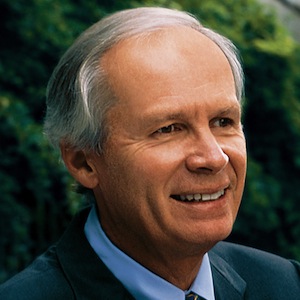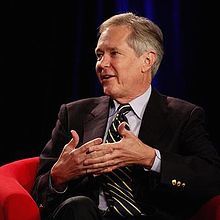Alex Jones: Well, it is my great pleasure to have as our guest for breakfast this morning Clay Christensen, who is known to everyone of course in this room very well. He is a distinguished professor at the Harvard Business School, but probably more importantly he is the author of a very, very influential book, “The Innovator’s Dilemma,” which is both given credit and blame for all kinds of terrible and wonderful things that have happened in the last decade. Clay, I’m not even going to bother to introduce you beyond that. I would just invite you to speak, and then we will have a conversation with everyone in the room.
Clay: Super. Well, I thought I’d talk in kind of a general way about the impact that the types of innovation that people can invest in is having on the national economy. Then we could through your questions apply it to a lot of different industries. Just one other thing you need to know, I had a stroke about two years ago. A clot came from somewhere and lodged itself right here, and it killed about a quarter of the left side of my brain. Unfortunately, the part of the brain that died is where you formulate speech. I was giving a talk in a church meeting, and all of a sudden I just couldn’t speak.
Nor could I write, so I have been over the last two years trying to learn how to speak again. I got Rosetta Stone for English, started with Level 1, Lesson 1. You can sense how well I can speak, which is not as well as I used to. I’m speaking to the table, not to you. [laughs] The reason is, if I look at you, sometimes you distract me. If I look at the table, I can think about what’s the next word. I apologize for that. It’s not that I’ve become shy. It’s the way I deal with the problem.
I’ve been thinking a lot about disruption in two contexts. The first one is that it’s very clear that disruption is the fundamental microeconomic reason for nations’ microeconomic prosperity. If you have thought much about economic history, you realized that through the 1950s and early ’60s, Japan was just an impoverished nation. Because of their poverty and the low cost that accompanied that, Japan’s economy disrupted the West.
Those included Honda, which attacked America with rusty little bikes that were motorized, that they called a cub. Toyota came into America not with Lexuses, but a rusty little sub compact that we called a Corona. They made it so affordable and accessible that the rebar of humanity, the college students, could own a car, thanks to Toyota. Canon disrupted Xerox by making just little simple boxes that couldn’t compete with Xerox, which is a very high speed copy machine. We could go on and on.
Japan, through the 1960s, ’70s and ’80s was growing like a juggernaut at rates that were unprecedented. Then in 1990, Japan’s economy just died. For 20 years they’ve been in a stagnant swamp.
Korea, Taiwan and Singapore came in underneath Japan and disrupted them, just like Japan disrupted America. They have their Kias and their Hyundais and Samsung that have taken the wind out of the economic sails of Japan. Now Korea, Taiwan and Singapore, themselves, are perilously at the top of the market, and here comes China.
China is just in the middle of this revolution that’s transforming not just the products that they target, but the whole nation. And then Viet Nam is next. You can already see them at the bottom of the market.
The big question in my mind is why these disruptions from Asia transformed the economic fabric of Asia, but why hasn’t Mexico disrupted America, or Latin America, in general? Because they’re in the same position that the Asians have had, but there’s been no disruption, either within Latin America or into North America. Nor have any African or Middle Eastern nations disrupted anybody.
They are stuck in poverty because they haven’t, for reasons that I’m just thinking about, they haven’t disrupted anybody. That’s one piece I’m thinking about.
Another one, which I think I would like to go through in more detail, is in the American economy there have been nine recessions since World War II. In the first six of the nine recessions, from the time that disruption hit bottom to the time it then took to rebound past the previous peak was six months.
But in the seventh recession, which occurred in the early 1990s, it took the economy 15 months to reach the prior economic peak. In 2001 2, it took us 39 months to get to the prior peak. And now it’s been 65 months, and we’re still way below the prior peak.
There clearly is something going on that is fundamentally disarming our economy, and why this is is the question that I’ve been thinking about. I have a hypothesis that needs a lot more work, and solutions need to be much better than what we can understand right now, but this is my model.
There are three types of disruption, or three types of innovation. The reason why innovation is, in my mind, the focus of macroeconomic growth, is that, in fact, these are the things in which investment occurs. There are disruptive innovations.
Just in your mind, think about, in your mind, a set of concentric circles. The centermost circle represents people who have the most money and the most skill. And then, as you come to the larger circles, they represent larger populations of people who have less money and less skill.
Historically, almost always the technology that was the initiation of a new market always starts in the middle, because the first products are so expensive and complicated that only the richest people can own them and use them, and people with a lot of skill can use them.
In computing, for example, the mainframe computer put computing on the map. They cost about $2 million, and so only the largest corporations and the largest universities could have one, and it took years of training to operate those things. Then the personal computer emerged, and it made it so affordable and accessible that plain ordinary people like Clay Christensen can actually own a computer and use it.
At the beginning, the personal computers we could use just for simple things. But as the computer got better and better and better, we didn’t have to take the complicated problems to the mainframe center where the experts solved it for us because we could solve these problems ourselves. Now you have the smartphones that are disrupting the personal computers, and a much larger population of people now have access to computing in a convenient way.
That’s what disruption is, is it transforms complicated expensive products into things that are so affordable and accessible that many more people can own them and use them. Historically, by my calculations, these kinds of disruptive innovations accounted for nearly 100 percent of all of the jobs that have been created in America in the last 100 years.
The Model T was a disruptive innovation. It enabled a larger population of people to own it and use it, and so on. They require capital, because they need to expand their growth. When you make something affordable and accessible, so many more people are buying the product that you have to hire people to make it and sell it and distribute it and service it. It creates engineering in software, around the hardware and so on. That’s the first one. Disruptive innovation creates jobs, use capital and so on.
Then the second type of innovation in our research we call sustaining innovations. Sustaining innovations make good products better. They’re very important in the economy. Sustaining innovations account for the lion’s share of investment in the economy, and they’re important. They keep the markets fresh and exciting, but they don’t create jobs. The reason why is by their very nature, these are your innovations that make better products that you could sell for better profits to your best customers. Whenever you succeed in selling the new product, you don’t sell the old product.
Toyota has a marvelous innovation on the market. It’s called the Prius, which is a hybrid car. A wonderful innovation, but every time Toyota succeeds in selling a Prius, they don’t sell a Camry. By their very nature, these kind of sustaining innovations are important but they don’t create growth. They don’t create jobs. They don’t need more capital, because it’s replacetive in character.
Then the third type of innovations we call efficiency innovations. They’re primarily process based innovations that allow companies to deliver the same products, but at a better price.
Walmart is an efficiency innovation. They can get market to the product, products that are 20 percent cheaper. When Walmart puts a store in a community, they hire a lot of people. But the people who get driven out of business are the small mom and pop folks, and so they take jobs out of the economy on aggregate. They’ve got to do it, because if they don’t make the economy more efficient, then we lose even faster.
Another important element of efficiency innovations is they emancipate capital, or free capital from prison. What I mean by that is, before Toyota came to America, it took General Motors and Ford about 60 days to assemble a car through the assembly line. Because it took that long, there was all kinds of work in process inventory on their balance sheets. Therefore they had to have capital to support all of that work in process inventory.
The Toyota production system, they figured out how to make cars in 2 days rather than 60 days, and so they didn’t need to have capital to support all that work in process inventory. The capital previously had been imprisoned on the balance sheet. Now the Toyota production system, which is an efficiency innovation, emancipates the capital so it can come off the balance sheet and is available to do other things.
Those are the three types of innovations. Disruptive innovation creates jobs, use capital. Sustaining innovations are very important, but they have a neutral impact on the economy. Efficiency innovations reduces employment, but emancipates or frees capital. As long as the economy is creating more jobs through disruptive innovation than efficiency innovations take out, the economy grows almost like a perpetual motion machine.
That was the case for the last 100 years, but things started to change at a very low level in the 1960s, and then it has come to a crescendo. There has emerged in our economy a new church, and I call it the Church of New Finance. I call this movement a church because the people who belong to the church, finance folks, believe as deeply in their religion of finance as the Mormons believe in their religion.
What is their religion? Well, there’s a guy named George Gilder, who’s kind of a guru in a lot of things that he shouldn’t be a guru about. He’s a very smart guy. He gave us a paradigm which asserts that, if there is an input into production that is scarce and costly, then you don’t want to just use that anywhere. You want to deploy that costly, scarce input only to applications where it can be leveraged maximally.
You want to husband its use. If there’s something that is abundant and cheap, you can waste it. Like sand. When new finance and this new church was emerging, through the 40s, 50s and 60s, in our economy, capital was scarce. Because it was scarce, capital was costly. You needed a rate of return on that capital of 20 to 30 to 50 percent, because in fact, it was scarce and costly.
To help managers decide how to carefully deploy this scarce capital, the finance community gave us new measures of how to finance or how to measure how efficiently you’re using your capital. Prior to this, the way managers measured profitability was with crude measures, like tons of cash.
Now the finance people give us more sophisticated ways to measure profitability. One of them is return on capital employed. This is a ratio. In fact, every one of these metrics to measure how efficient you’re using capital is a ratio. How do I get that ratio up? I could invest in disruptive innovations and create markets that generate lots of profit and put that in the numerator of this ratio.
But what the heck, I could also outsource everything to get assets off the denominator of the ratio. Either one makes the return on capital employed go up. It turns out to be a lot easier to get the denominator down then to get the numerator up. There’s another important measure called internal rate of return. It’s a ratio where the denominator, essentially, is time.
How much time does it take to get the returns? Sure, I could create new, growing industries, create profitability and put it in the numerator of that ratio. But what the heck, if I only invest in things that pay off very quickly, then time in the denominator goes down. They gave these measures of profitability to managers. These measures of profitability began to be taught with the same fervor in finance, as Billy Graham teaches his religion in churches.
Truly. The MBAs get baptized into this way of thinking. Then they join hedge funds, private equity funds, venture capital funds. Or they get positions in operating companies in finance. Whenever they have an opportunity to invest capital, they look at these measures of profitability against the business plan. They say, “This is a disruptive innovation. It only pays off in five to ten years. If we invest in there, our internal rate of return will tank.”
“If they start to grow, we have to invest capital to expand their capacity. That puts assets on the denominator of return on capital employed. On the other hand, lades and gentlemen, if we take that money, cycle it around and invest it again in efficiency innovations, it pays off in a year. Most importantly, we can take out more capital than we put in, because efficiency innovations free capital.”
So they get more capital. Then they look at the next thing comes in and say, “Damn, this is a disruptive innovation. It pays off in five to ten years. It uses capital. Return on capital employed tanks. Internal rate of return tanks. On the other hand, maybe we could put our money in another company and it pays off in a year. We can squeeze out even more capital.”
So they do that. Then another opportunity to invest shows up and they say, “Jeez.” Have I said this story before? Because, in finance, we teach people to measure profitability in the ways that we do it, it becomes illogical to invest in disruptive innovations. Over the last 20 years, our economy has generated about 20 percent of the number of disruptive innovations than were created in the fifties, sixties, seventies and eighties.
The reason why our economy, from a financial point of view, seems to be robust, but the real economy is not creating jobs, is that the finance economy can’t invest in those things that create jobs. They just have to cycle it around again and again. Now we find ourselves in a strange position, where George Gilder said that if something is scarce and costly, you need to husband its use.
But if something is abundant and cheap, you can waste it. Now, capital is like sand. The cost of capital is essentially zero. In America, the private equity funds in aggregate have about a trillion dollars of capital. Not a billion. A trillion dollars of capital. There is no place to put their capital. Every time they have an opportunity to invest in disruption, it makes no sense.
They reinvest it in ringing out the last possible piece of efficiency. When Silverlake tries to take over Dell, what are these guys going to try to do? It’s not to invest in growth. It’s to get even more out of that company. People who are trying to start disruptive companies just bewail the fact that there’s no money. They can’t raise money.
The people in the private equity shops bewail, “We have so much money going after too few deals.” Coleridge wrote a piece called “The Rhyme of The Ancient Mariner.” This poor guy was afloat in the ocean. He says, “There is water, water everywhere. But not a drop to drink.” That’s where we are. What’s the future of America?
All you’ve got to do is look at Japan. Because all investment in Japan was going into disruptive companies. That includes Sony, Honda, Toyota, Canon, Mitsui. Their economy was growing like gangbusters. But in about 1990, the using of these metrics of profitability that people learned from coming to America to get MBAs started to be used pervasively in Japan.
Since 1990, Japan’s economy has produced only one disruptive innovation. That was the Nintendo Wii. That’s the only one. There is capital everywhere in Japan. They can’t invest. They keep reducing the cost of capital to zero. They can’t invest. They’re paralyzed. Instead of these three types of innovation being in a circular way, where you use your capital to invest here, Japan decoupled it and it’s in a straight line.
They started with an investment in disruption, then focused most of it in sustaining. Now they focus in efficiency and it ends. If you put it out in a line, there’s a beginning of an economy and an end of an economy. That’s what I worry about for America. In the end, in most problems in business, the root core of the problem is the professors, the management.
[laughter]
Clay: Anyway, that’s what I’m thinking about. Questions, comments, criticisms, cannonballs? Not just mine, but any other topic.
Alex: Let me ask you the question that is begged. What do you think could be done about this?
Clay: Go to Vietnam. Because that’s the next one. What do you do in America? There are some simple, obvious things. Right now, if you keep your money in an investment for 366 days, the tax rate jumps from 35 down to the Romney rate of 15 percent. The problem is that 366 days isn’t long term capital. So they need to get rid of that and migrate it down to the point where, if your money is at work in a company for five years, the tax is zero. Maybe negative even. But you’ve got all this capital. It may be possible that the tax system could repurpose some of this capital so that it wants to go in disruption. That’s one possibility. Another possibility is to convince the high priests in the new church of finance to recognize that it’s an apostate church. A good theory always is a circumstance contingent problem.
In other words, if somebody gives you a theory, like the finance people gave us, and asserts that this is the way you should approach any problem you know they’re always wrong, that it has to be circumstance contingent. If you find yourself in this situation, do it this way, but if you’re in this situation don’t do it this way. These are the rules.
If they taught their theories in this way they would assert the way we measured our success through the ’50s, ’60s, and ’70s was we were very careful and efficiently deployed our capital and that was the right thing to do in that circumstance when capital was scarce. Now, ladies and gentlemen, we’re in this other situation. All of the measures of return on capital are irrelevant. Truly irrelevant.
What meaning does return on capital mean when capital cost is zero? It is actually nonsensical. Is that a word?
Alex: Yeah.
Clay: Calculating net present value where future cash flows you divide by one plus the cost of capital and, therefore, it causes you to invest only in short term things. Now you do the math. One plus zero means that net present value has no meaning. What George Gilder would say is because capital is abundant and cheap we can waste it. What’s scarce and costly, I think, are the people that we employ and we’ve been wasting people and education. Now that’s what’s scarce. I bet you that in 10 years there will emerge another way of measuring profitability which is investments in making our people to become more capable people. I’m not a left wing whatever out there. I was raised in a home that was so capitalistic that I didn’t know the word dumb Democrat was two words until I was in my teens. Given that, I really do think that there will emerge other ways of measuring profitability that have nothing to do with capital because it’s people. Those investments will get the most leverage.
Alex: You’re probably one of the most influential thinkers in the world about these kinds of things. Are you putting these thoughts into a new book?
Clay: Yes. I’m calling it “The Capitalist Dilemma.” There’s a problem with the business model that we’re all engaged in, though, which I don’t mean to say that I’m in despair. When we write a book we think that we’re writing to the world. The problem is on the other side the idea is consumed individually and so somebody will read “The Innovator’s Dilemma,” for example, and they’ll just get so psyched up that, holy cow, we’re one of these. If we just change our strategy we can do this. You go to work on Monday morning and you pull your team together and you explain, “You guys, this is going to solve this,” and everybody else in the room didn’t consume the idea with the leader and their response is this makes no sense at all. Within two weeks, her excitement for the idea just gets dissipated and nothing happens because the idea is consumed individually, even though I write it for the world.
There are ways to get large groups of people to consume the idea, but that’s actually really hard if it entails changing what you do on Capital Hill. They can’t consume the idea in unison.
Alex: What’s your view of David Stockman’s book?
Clay: I’m ashamed to say I haven’t read it. I should. Can you tell me about it?
John: It’s about this thick.
Alex: It’s very thick. He uses the word despair, too. Basically, he says there’s no hope. America’s going down the tubes. That’s it. It’s over. Forget about it.
John: If you remember in the 1990’s when James Fallows told us that we’d all be working for the Japanese and the Japanese economy was the way to go, centralized thinking. Then this little thing called a personal computer took off and venture capital took a different approach to financing, innovation, than normal equity market financing, et cetera. You know all this. Now we have private equity, which was putting all this debt on companies and shrinking them down for efficiency. You still have companies like we were just at Facebook last week. It’s seven years old and it has 25 buildings on its campus. Somebody was financing innovation there and apparently getting a return. My question is, there’s some kind of balance between equity financing, private equity, venture capital. What should the next one be to finance innovation? Also, to do that doesn’t it kind of require a new thing like the personal computer?
Clay: Yeah. Those are the things that create growth and there are a lot of them out there that the money can’t get to them. I’ll tell you a story that occurred when I was at Intel that really helped me. Helped me frame the problem of these. “The Innovator’s Dilemma” had just been published and I was just working in my office minding my own business and Andy Grove, who’s the chairman of Intel, called me up just out of the blue. He has a very gruff voice. He’s a very gruff man. He’s so gruff that I remember every word. He said, “You’re Christensen?” I said, “Yes.” He said, “I’m Andy Grove. You’ve heard of me?” I said, “Yes.” He said, “I hear you’ve written a book and I don’t have time to read academic drivel like you guys put out but some engineer in our company read this book and she says that you’re predicting that Intel is going to get killed and I need to know why you think we’re going to get killed.”
I said, “Actually, I know nothing about Intel, but I’d be interested to meet with you.” So he said, “In two weeks we have a meeting of my direct reports. I’ll give you 30 minutes to tell us why you think Intel would get killed.” I reminded him that Intel isn’t mentioned in the book, I know nothing about Intel.
Anyway, I show up and in this gruff voice when I walked in the room he said, “Look, stuff’s happened to us, we don’t have any time for you. Look, I’ll give you 10 minutes. Just tell us what this means about Intel.” I said, “Andy, I don’t have an opinion, but I have a theory that has an opinion on Intel. What that means is I’ve got to explain the theory and then.” No one ever told him theories had opinions so he sat back.
Five minutes into it he chopped me off and he said, “I got your stupid theory. Tell us what it means for Intel.” He explained that he really did get the theory of disruption. I said, “Look, before we can talk about Intel I need to describe how this process of disruption worked in an industry totally different than yours so that you can, in an abstract sense, see how it works.” I described how Toyota came in with rusty little sub compacts called the Corona.
This was in 1997. You see that Detroit was dead. Grove said, “OK. I get it. What you’re telling me this means to Intel is,” and he went like this and he said, “There are two of these Toyota Coronas at the bottom of our market and they’re just killing us down there and it feels good to be killed because when we lose volume in the lowest profit parts of the product line our profitability improves as we retreat. So what you’re telling me I’ve got to do is go like this and kill those buggers and then come up.” That’s what they called the Celeron processor.
I learned one thing, but I’ve got to extend the story. If I had told Andy Grove what he should do about Intel I’d have been killed, but rather than teaching him what to do I taught him how to think. Then it was obvious what he should do.
I started doing this I think you noticed that. I always have to use a theory before. I was then interested that Andy Grove didn’t stand up in front of the company and announce, “Ladies and gentlemen, we’re going to go to the bottom of the market,” because it just was counter to the profit logic of the company.
What he did was he set up a seminar. Lasted a whole day, brought 100 people at a time, and he did it 20 times over the course of a year. That’s 2,000 of his top people spend a whole day on disruption. I did it first and handed it over to him. We present a little about the theory, break out groups to discuss is this happening to us, present a little bit more, break out groups to discuss how could Intel disrupt other people, and then break out groups and discuss how do we need to reorganize ourselves.
Last year, Intel shipped about $30 billion from products that bubbled up out of these break out groups. Had they not done that, Intel would have been blown off. They’re in trouble now because they needed to keep doing this, which they haven’t done since Grove left. I talked with Grove a couple of years ago about how he created all this growth and he said, “You know, your stupid theories don’t give us any answers but they gave us a common language and a common way to frame the problem so we could reach consensus around counter intuitive courses of action.”
I just thought that was brilliant.
Paul: Of course, what they missed later was what was abundant and what was a scarce resource. It turned out it’s electricity in the next generation.
Clay: That’s exactly right and they just completely missed that and they shouldn’t have.
John: Electricity is of short supply?
Paul: Sure because in a server you plug it into the wall and power is cheap and flows like water and in a phone power is your biggest problem and the battery dies if the processor draws too much and they got killed.
Clay: That’s exactly right.
Paul: Can we ask you to relate this theory to the news business? We’ve been working on that and interviewing people and we haven’t found a dumb one yet. You can look at a 40 year arc of change of digital technology coming to the news business. Many people who absorb your theories, can quote it, understood, try to invest, and they still got killed in the end. We’re trying to figure out is it that they didn’t absorb it enough or that sometimes there is some disruptive force that goes beyond the profit dilemma that you just can’t do anything about if you’re standing on the wrong shore.
Clay: Great question, Paul. Let me offer two answers, one of which is its cause is finance professors, also. There are some that have set up online entities like boston.com and so on and as long as they stayed and were managed independently they actually were quite successful. They don’t employ as many people. In finance, we teach our students this paradigm that you should always ignore sum costs and fixed costs and only look at marginal costs and marginal revenue.
If you’re looking at the cost of creating a completely new entity like boston.com versus the marginal cost of using our existing organizational structure and lay this on top of that, when you’re a manager and you look at on the menu the marginal cost of using what we have versus the full cost of creating something new, always the marginal cost trumps.
You might send it out, but marginal cost thinking every day causes the accountants to want to pull it back in. That’s one problem is that many of those that could be at the next generation of business just gets brought in and killed.
The other one, which I think is more productive, is a subsequent theory that is in chapters five and six of the next book called “The Innovator’s Solution”. What it says is that if you think of there being a layer. In telecommunications we call it the stack. Michael Porter would say these are the value adding process steps to get something to a full product. If at one of these layers something is getting commoditized through disruption it will precipitate a wave of decommoditization and growth opportunities at the layers above and below.
It’s true that if you’re in the layer that’s getting disrupted you might go to the beach at low tide and stand out and hold your arms up and command that the tide not come in and the tide actually doesn’t care. Commoditization just happens, if you just sit there. Instead, when this happens very often it unearths growth opportunities the other way.
I’ll give you a couple of examples and then talk into the news business. A car has become commoditized because the components inside the car are made by the same group of people and so competitors, inside it’s all the same. They can’t differentiate themselves. On top of it, there are a number of these things, but at General Motors, which is getting killed at this layer, they started this thing called OnStar that is the next layer up.
This year, OnStar will generate about $4 billion for General Motors and their net profit is one billion dollars and it has negative net assets. It’s a marvelous product.
Alex: What is it?
Clay: OnStar?
Alex: Yeah. I’ve never heard of it.
Clay: It comes only on General Motors cars. It has 1,500 sensors in the car and so if you ever get in an accident it will immediately dial 911 for you and tell the police exactly where you are and they will tell you that the force came from the front, the left so that the ambulance people can get prepared for what kind of surgery they might see. Then they will call somebody else if you want somebody else to come.
Alex: I got it.
John: It also has a concierge that can tell you where to find the good barbecue restaurant.
Clay: The best thing about it is if somebody steals your car they can tell that the person driving the car is a thief and you hear the voice of God come out from the top and it says, “I know you’re a thief. I want you to pull this car over to the side because in 10 seconds I’m going to take the power out of your engine and if you stop in the middle of the road you’re going to get killed. So pull it over but, by the way, don’t think you can get out because I’m locking the doors and the police will be there in about 80 seconds.” It’s marvelous. [laughter]
Clay: As this happens and Skype commoditized the transportation of data, and you look at all of the things that have emerged on top of Skype, and when eBay bought it they just, “Oh my gosh, we’ve bought a commoditized business,” and other people then build things on top of it and below it. In this industry, I think that what’s happened as the core business is commoditized is on top of that, extraordinary entrepreneurial opportunities are emerging. I look at what happened to Businessweek and Fortune versus Forbes, and I’m a bit proud to say that Forbes read this stuff and thought about it. The other two just wrote it off.
I think what Forbes has done is, rather than employing the journalists, they let them be independent. But a whole bunch of them have created blogs and businesses around blogs in which these journalists have become the people to go to, the big names in different dimensions of business news.
They as entrepreneurs have been very successful by creating a business around their thinking, whether it’s good or not, and so Forbes becomes a platform on which these people pay to have a podium of dissemination of truth, and they can aggregate stuff. It’s worth thinking about how they did it.
Paul: I don’t want to talk much more, just one question. How much do you think the challenges were the economic analysis, the business professors problem, and how much is also a cultural question? Because we met an awful lot of people who saw this and didn’t even deny it going on, but didn’t necessarily have… We’ll jump to the end and come back, which is a lot of the innovation that’s been successful in communication or what looks in many ways like [indecipherable 53:22] has taken pieces of its business, like advertising, was engineering driven. It was a really different set of people with different training so it wasn’t just let’s use your steel example both sets knew how to make steel but they took a different economic model.
Clay: Yes.
Paul: This was almost a different set of folks with completely different training. It wasn’t just an economic problem.
Clay: Yeah, you’re exactly right, Paul.
Paul: What does an industry do then? What’s the possible course, or do you just have to realize you can yell at the tide, but it’s not going to stop?
Clay: I’m trying to learn about this stuff, too.
John: Another way of phrasing that question is Google has almost 50 percent of the traditional revenue share of the news business now, almost 50 percent of the advertising share. They’re a pure engineering company, and they’re competing with all these other companies that have an engineer here, an engineer there, but they’re a content creation company, so…
Clay: There’s another piece of our research that I think can be useful, if you define your job correctly at the beginning, OK? In this case we implicate the professors of marketing as the cause of this problem. Here I am, Clay Christensen. Unfortunately, I have all kinds of attributes. Unfortunately, I turned 61 years old last week. Unfortunately, my shoe size is 16. Unfortunately, I’m six feet eight. Unfortunately, we sent our youngest daughter off to college. I have a lot of other characteristics and attributes, some of which are good, but these characteristics have not yet caused me to go out and buy “The New York Times” today.
There might be a correlation between my characteristics and the propensity to buy “The New York Times,” but they don’t cause me to buy “The New York Times.” What causes us to buy something is, stuff happens to us. Jobs arise in our lives that we need to get done. Some of these jobs arise unpredictably. Sometimes we know they’re coming. When we realize we have a job to do, we reach out and pull something into our lives to get the job done.
The causal mechanism behind the decision to purchase you is, I have a job and this would solve the problem for me. The strange thing is that the conclusion of that is, that understanding the customer is the wrong unit of analysis. Understanding the job they’re trying to do, that’s what’s critical.
If you understand what the job is, then you know what are the experiences in purchase and use that we need to provide so that they will sum up to nailing the job perfectly? Then, what do we need to integrate and how do we need to integrate it so that we can provide the experiences to get the job done?
I’ll give you an example, but the job is a compass. The job rarely changes. It’s very stable over time. Out there somewhere there’s a job to be done, which is, “I need to get this from here to there with perfect certainty as fast as possible.” Julius Caesar had this job to do, but the only thing he could hire to do the job was a horseman and a chariot. Abraham Lincoln had the very same job to do and he could hire the telegraph or the railroad. Ronald Reagan had the very same job to do and he could hire FedEx.
The job itself hasn’t changed at all. If you focus on the job to be done and organize around that to provide the experiences to get the job done. Then, when new technologies come, if it helps you nail the job even better, people don’t ever compete against you.
I’ll give you an example about this and we can bring it to newspapers. If I say, you get a call from your sibling, and announces, “I just moved into Palo Alto. I’ve got to move into my new apartment tomorrow, and I need to furnish my apartment tomorrow,” that’s a job. Somebody has that job to do. Is there a name that pops into your head, when I’ve got to furnish my place tomorrow?
Paul: There are two options either Craigslist or Ikea. [laughter]
Clay: That’s right. That’s exactly right.
Paul: But not the “Mercury News.”
Clay: That’s right. Ikea has been focused on that job to be done for 40 years, and they have no competitors to do the job well. They used to make crummy furniture 40 years ago. They still make crummy furniture today, because they’re not organized around the furniture business. They’re organized around the job business. If you look at what’s happening to the newspapers, Craigslist picks off a job to be done. “The Metro” picks off a job to be done. Realtor.com picks up, and every one of them is focused on a single job to be done, and they do it well. The newspaper is trying to do everything for everybody and they can’t complete.
I bet you that if we could spend some time, there still are jobs to be done, for which there’s no compelling solution that you could organize around these things. It’s really important that you never try to do everything for everybody.
This would be fun if you guys want to talk about it. I have a few ideas.
Alex: I would love to talk about it more. Yeah, let’s do. Can you take two more questions, or we’ll leave it at two?
Clay: No, we’re OK.
Diane: Hi, my name’s Diane. I’m a second year student here at the Kennedy School. Thank you so much for talking to us. I listened to your talk with the Niemans where you talk about this topic. I’m thinking about it from a television point of view, because I used to work at a TV news network. I’m trying to understand what the analogy here might be of making the network a platform of some sort, because there’s the network that owns all these local stations. They either own or operate it, or they’re affiliate stations that are independently run.
What would that look like, transforming to this new medium where people are watching, getting information online from whatever destination? Does it mean completely getting rid of these physical television traditional broadcast based stations and transforming those to some kind of a model that’s just completely web based? It’s such a huge [indecipherable 1:01:47] I can’t even begin to fathom.
Clay: Yeah. That’s a great question. The first part of the answer is don’t think that way. Because from the customer’s point of view, they’re not in the television business. They don’t think about that. They have jobs that they need to get done, OK? Understanding these jobs will be applicable to the television business as well as the newspaper business. I’ll give you an example of one that kind of caught this. They came to us, I don’t know if it was Gannett or one of the others, owned a weekly newspaper in Palm Springs that was in Spanish. It was just struggling along. They kept thinking that we just need to get fresh news and timely news from Mexico to put in this newspaper, and so they’d invest in that but it had no impact on sales or profits whatsoever.
Then we taught them about jobs to be done, and we went out with them and just watched when a Mexican man bought the newspaper. What did they do with it? What they’d do is they’d flip through it and then they’d throw it away. What we figured is that the job they needed to get done was they had no interest in news from Mexico, where they came from.
Here I am in America. I’m a minority. I actually think that Mexicans are wonderful people and that our community here is a vibrant community, and instead of feeling like we’re at the bottom of the pyramid in America, we need to feel like we’re members of a vibrant community. What they did is they changed to try to provide the experiences needed to get this job done, which is they need to feel like they’re part of a vibrant group.
Step by step the news just disappeared from the newspaper, and more and more pictures of people who live there who are members of that community doing interesting things started to take more and more of the column’s inches. You just saw people just waiting to get this on Friday. They’d flip through it, and then they’d talk about the friends they know. “We need to tell them about what we’re doing, because…”
It became very successful because the job is different. If you think that the business is defined by the product you can miss stuff like that, but if you understand the job, you can…Now, that’s a very different business than journalism. Anyway. My guess is that customers don’t think about, “Oh, geez, should I go this from the newspaper? Should I get online? Should I watch television?” They don’t think that way, they have a job to do.
There’s a job, which is, “Oh my gosh, there is so much news out there. Can somebody please help me find the news that I need and that is reliable? Would somebody please do that for me, and could you ask them please to tell me what I need to know that I don’t know that I need to know, so that whenever I’m in a group people think that I’m well informed?”
Diane: The journalists need to be psychics and teachers, basically.
Clay: Yeah, but there are algorithms, like Netflix can tell you, “I think this is what you need to watch next.” Somebody could do that with the news. You really could, you know?
Student: Aggregation curation requires content to be aggregated and curated. What strikes me about jobs to be done analysis is it does leave a gap where a news organization might have a mission to inform the community. You were just mentioning jobs to be done analysis. Investing in news made no sense there. It seemed a little bit like what you were mentioning on return on capital invested, where cut the denominator because the denominator makes no sense here. If jobs to be done analysis is driving your product line, then it’s very hard to invest in a full product line to meet your entire mission. How do you balance between your mission to cover a community and the fact that in some cases that won’t necessarily serve the major job to be done?
Clay: OK, so a couple things. Once you talk about your mission, you can tell other people that…You need what I think you need, and you need to go around and figure out what’s the job. I think what’s happening is the two things that were just core to your profession, which is unearth the news, record it as best you can, and distribute that. The “New York Times,” their global network of journalists out there, nobody could copy that, but now anybody who has a cellphone can do that. That’s been commoditized, and in all cases what happens there is some of it is very accurate and insightful, and others is crummy and not accurate.
Then the other big thing is on their editorial. If you wanted to know what you need to know, you read the editorials. If they made a position on something, you aligned with them. They were very powerful, and now there are so many blogs that that’s been disrupted, too.
You need to then just go to the above and below to say, “Now, where else are there opportunities?” This idea, what it means is it’s a different business than what you’re in. If you want to preserve journalism as a profession, then you got to go to Forbes and do something like that.
Why are the community newspapers still quite vibrant? Right? Even though the national ones have gotten killed, and the reason is that every community has the same job to do as the Latino community in Palm Springs. Revere, Massachusetts. People who live there have the same job to do, and the local paper does that well.
That’s the problem. If you try to see the customer’s point of view, then you see an opportunity for you to get the job done well. Anyway, that’s not a very good answer.
Alex: If Clay can take one more?
Clay: Yeah, that would be fine.
Erica: Thank you so much, Clay. My name’s Erica, and I research millennials and how millennials and the next generation are looking at innovation. A lot of what I been seeing is that there’s a rise of, when you think about the printing press enabled a rise of IQ for humans because of books and newspapers. And in the same way right now with technology and new infrastructure we see a new type of connectional intelligence capacity. With that, concentric circles, those that are most powerful aren’t just innovating, but those on the tiers, a 24 year old using different tools, not just technology, but marshaling and sourcing differently is really happening.
I was really curious about what you’re seeing in relation to innovation across generations, given that we’ve always seen that innovation has come from the edge of ecosystems. Is there anything different that you also see with this new generation?
Clay: That’s a great question. I don’t have much to say, other than that the way you’re framing it is really important. You’re looking at me, Clay Christensen. On the street, if you ask people, “Who are the best thinkers about innovation?” almost all of them will put Clay Christensen as one of the top three, unfortunately. But actually my personal habits relative to technology froze around 1990. Paul, I bet you have similar things, even though you created this magnificent company.
John: He’s an early adopter. He’s all over.
Clay: Is he? [laughter]
John: He’s actually a show off. [laughter]
Clay: So you have all of these things that go on, and the next generation catches it because their habits are still fairly fluid. And for the people behind, there need to be companies that emerge that transform this into things that we can use. That actually really is an important insight that you have, is as the baby boomers come to this age, that translation doesn’t occur. They give us very simple things that from a technical point of view are simple, but from the jobs to be done point of view, they’re not solving that problem for us. Anyway, great question..


















